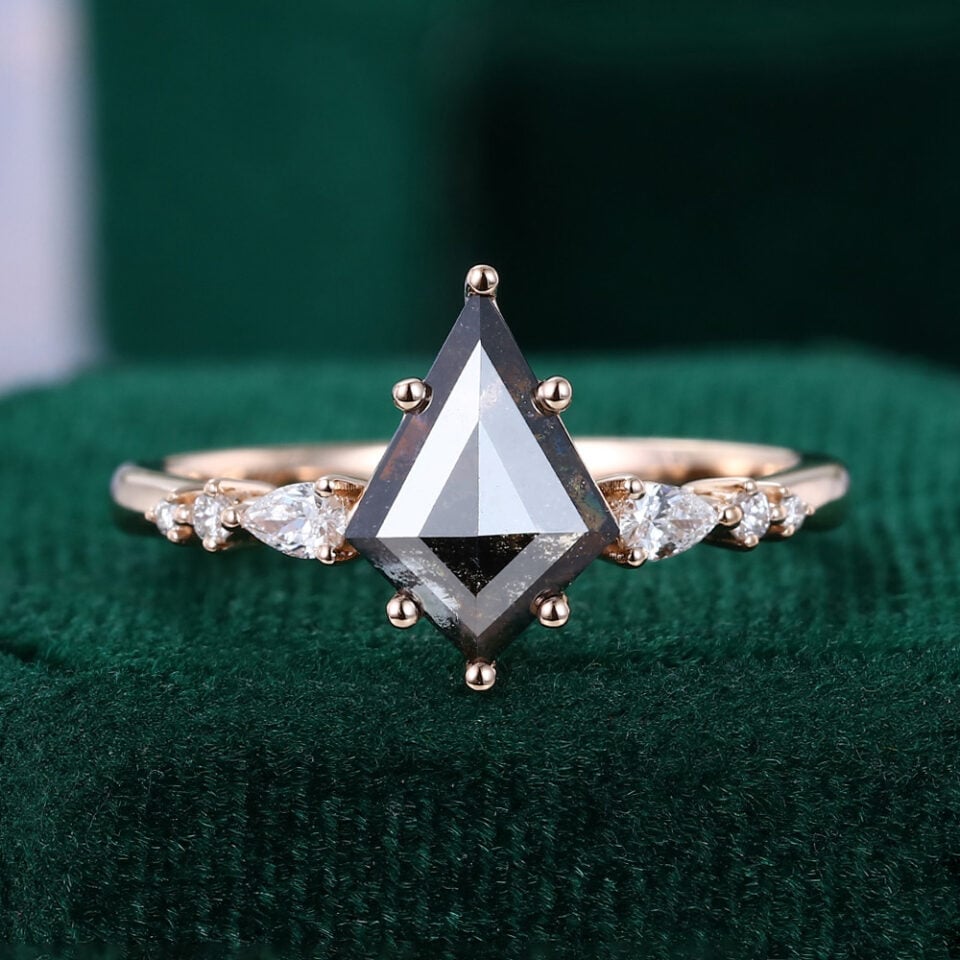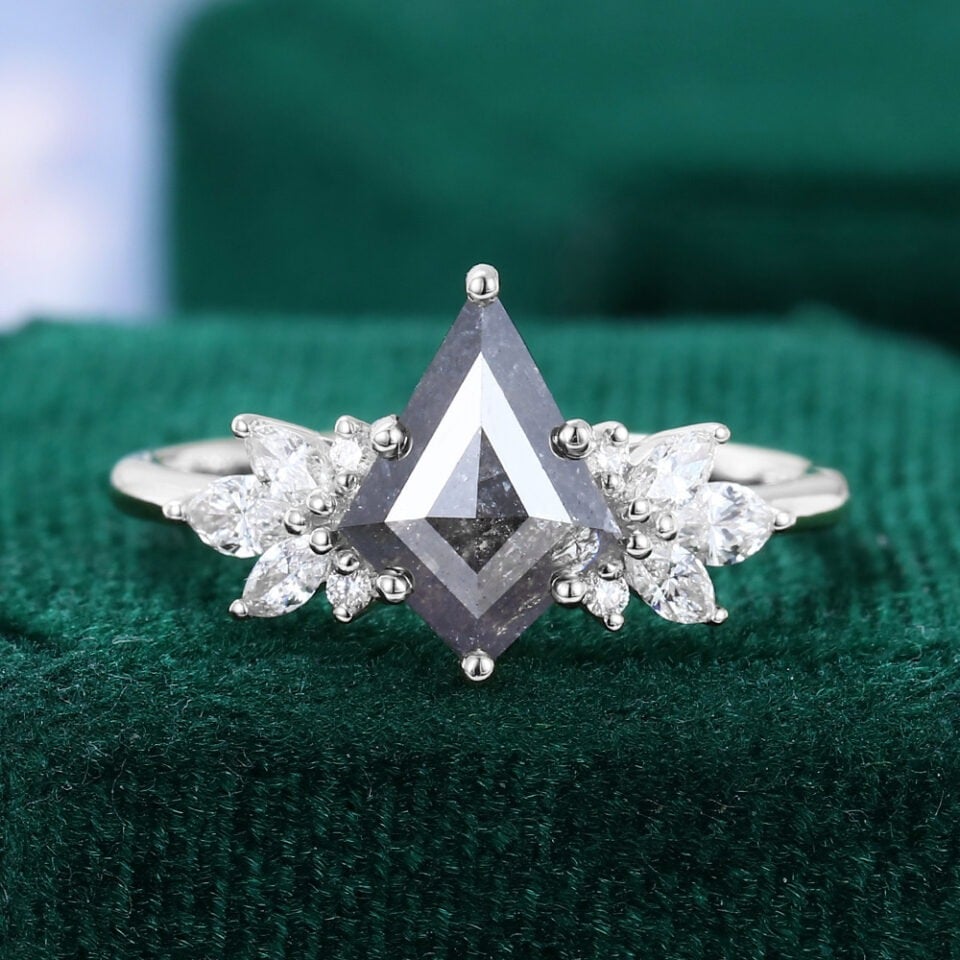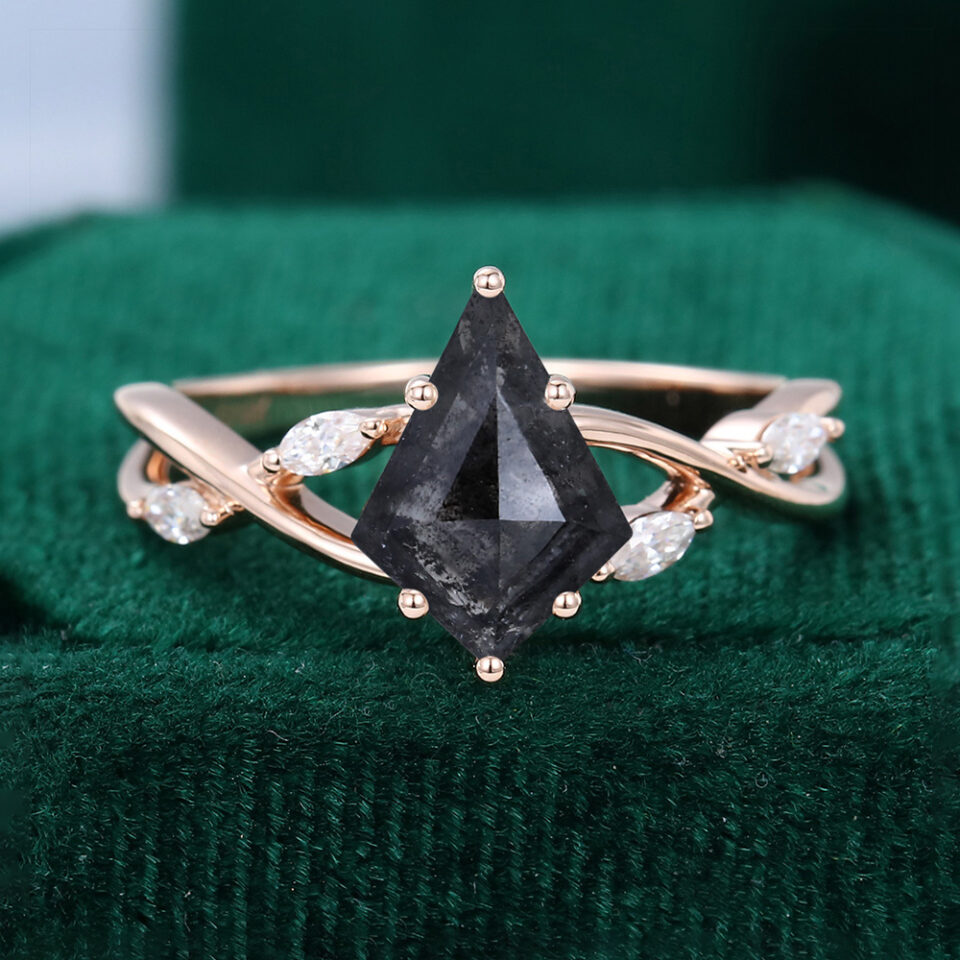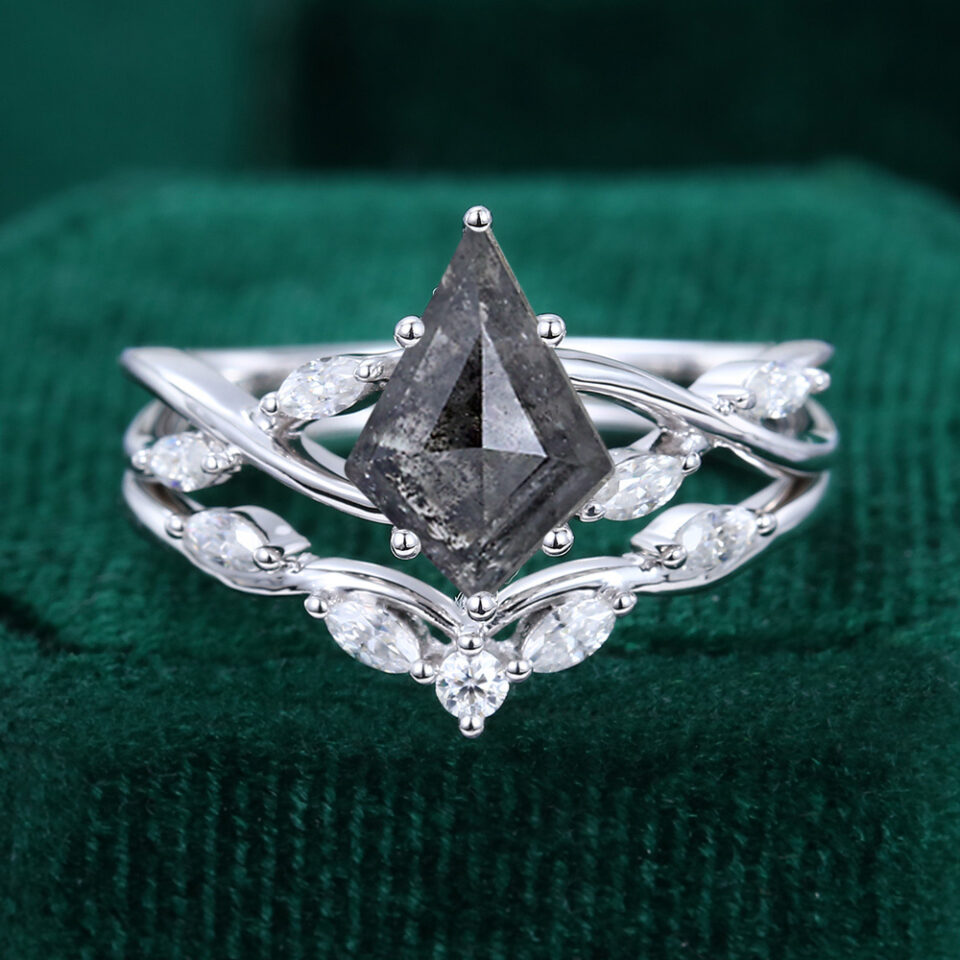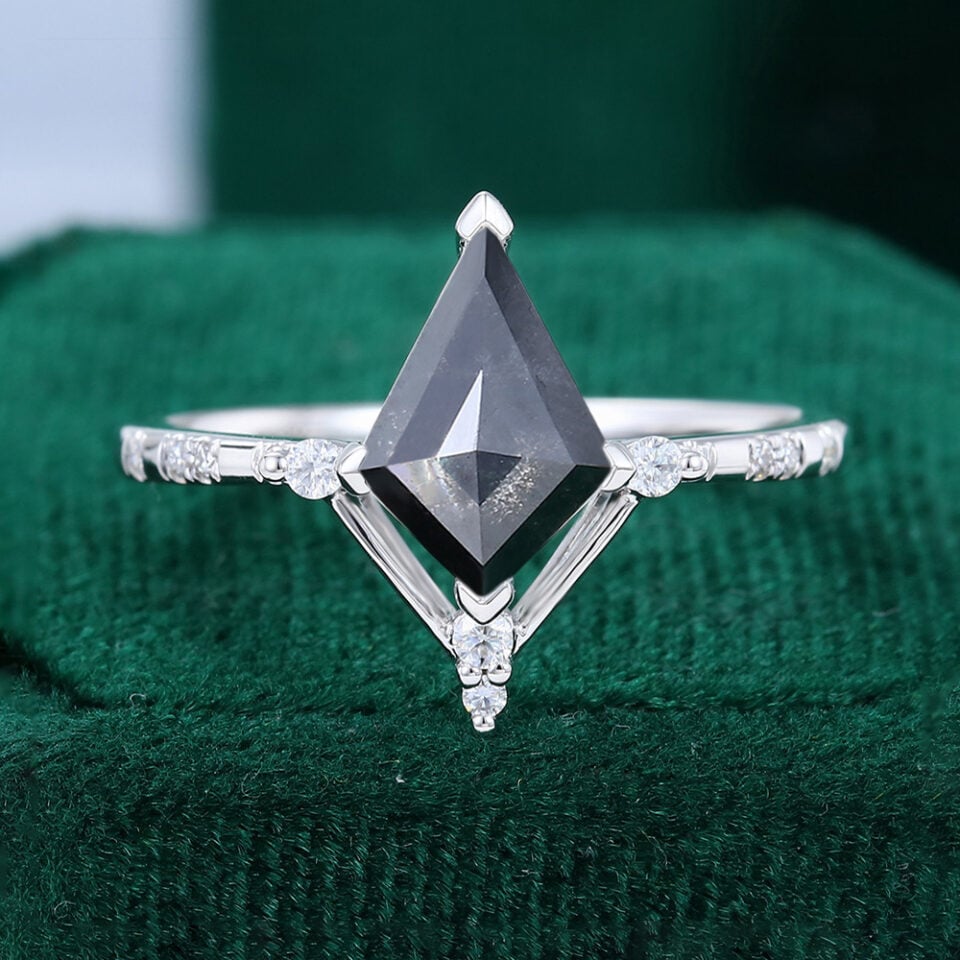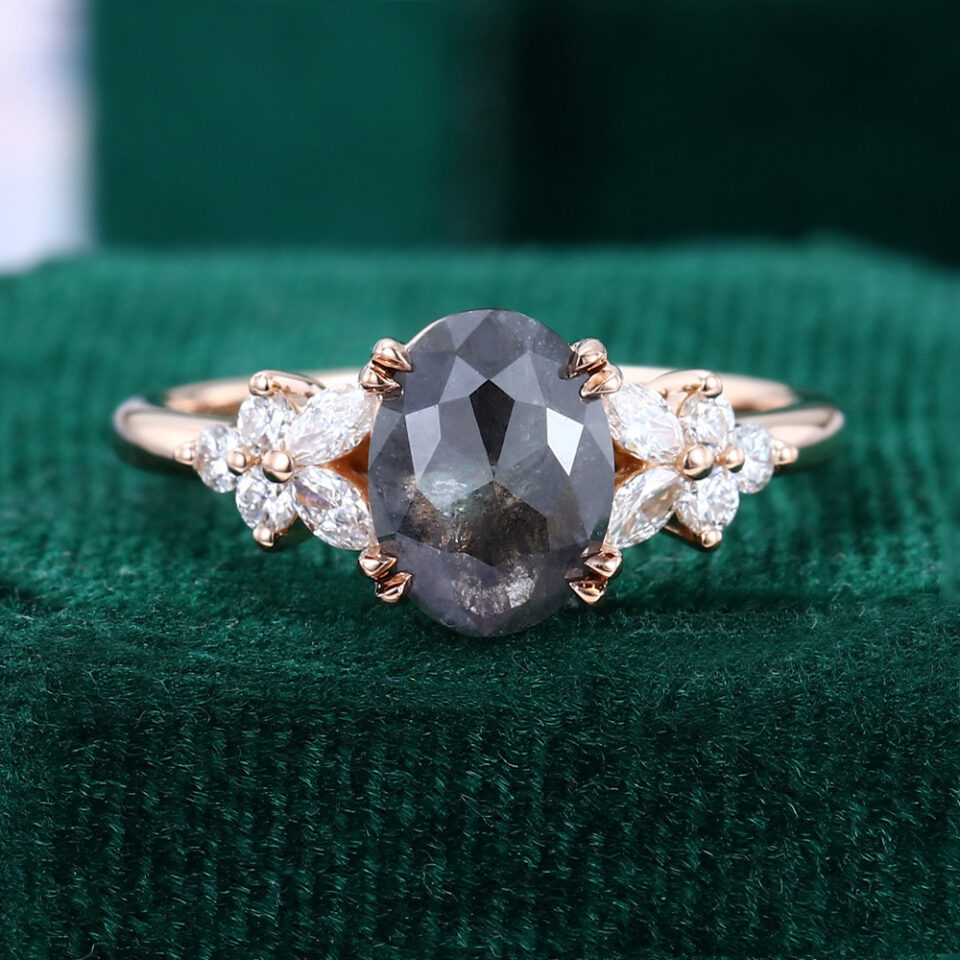Understanding the Clarity of Salt & Pepper Diamonds
Understanding the Clarity of Salt & Pepper Diamonds
Learn how natural inclusions create each diamond’s unique pattern and brilliance.
Redefining Perfection: The Salt & Pepper Diamond Movement
Once, perfection meant clarity, a diamond that was colorless, flawless, and precisely cut. Anything else was cast aside.
But love is not flawless, and neither is nature.
Salt and pepper diamonds remind us that true beauty comes from authenticity.
They are natural diamonds with visible inclusions that form organic, galaxy-like patterns.
Each inclusion tells a story, showing that beauty lies not in perfection but in character.
Redefining Perfection: The Salt & Pepper Diamond Movement
Once, perfection meant clarity, a diamond that was colorless, flawless, and precisely cut. Anything else was cast aside.
But love is not flawless, and neither is nature.
Salt and pepper diamonds remind us that true beauty comes from authenticity.
They are natural diamonds with visible inclusions that form organic, galaxy-like patterns.
Each inclusion tells a story, showing that beauty lies not in perfection but in character.
What Are Salt & Pepper Diamonds?
What Are Salt & Pepper Diamonds?
Imagine a diamond sprinkled with nature’s own seasoning. That’s a salt and pepper diamond! These real diamonds feature natural inclusions that create unique, speckled patterns. The “salt” appears as white or transparent flecks, while the “pepper” shows as darker, often black specks. Every stone is a tiny work of art and truly one-of-a-kind.
Formed deep within the Earth under intense heat and pressure, these inclusions are minerals trapped during creation, Mother Nature’s own special seasoning. Some even contain graphite, pyrite, or tiny diamonds within the diamond itself.
Beyond their beauty, salt and pepper diamonds symbolize individuality and embracing imperfections. Many couples choose them for engagement rings to reflect a love that is uniquely theirs, not perfect but perfectly them. These rings balance tradition and modernity, making a subtle statement that is unforgettable. If you want a wedding ring as unique as your love story, a salt and pepper diamond might be just the ticket.
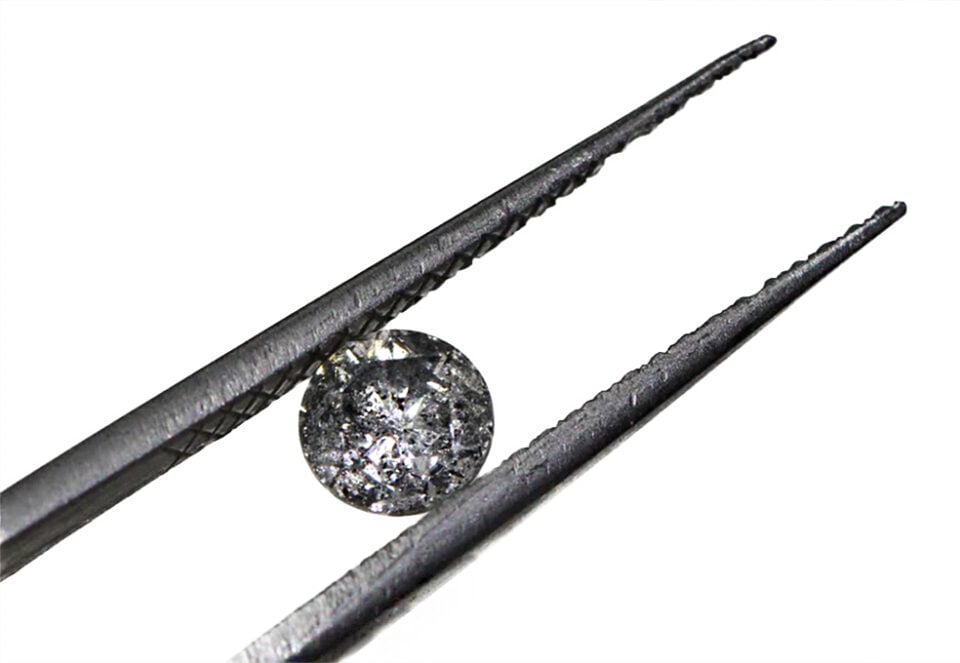
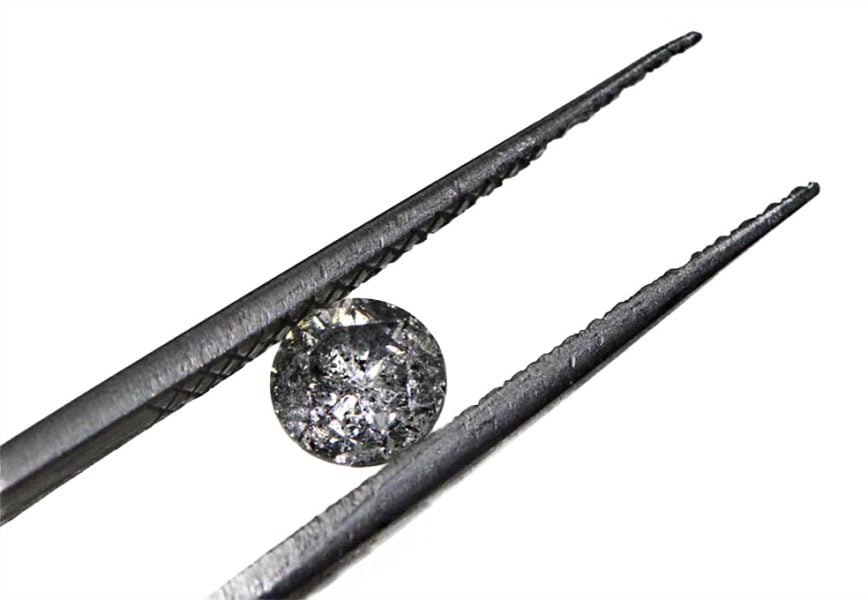
What Are Salt & Pepper Diamonds?
What Are Salt & Pepper Diamonds?
Imagine a diamond sprinkled with nature’s own seasoning. That’s a salt and pepper diamond! These real diamonds feature natural inclusions that create unique, speckled patterns. The “salt” appears as white or transparent flecks, while the “pepper” shows as darker, often black specks. Every stone is a tiny work of art and truly one-of-a-kind.
Formed deep within the Earth under intense heat and pressure, these inclusions are minerals trapped during creation, Mother Nature’s own special seasoning. Some even contain graphite, pyrite, or tiny diamonds within the diamond itself.
Beyond their beauty, salt and pepper diamonds symbolize individuality and embracing imperfections. Many couples choose them for engagement rings to reflect a love that is uniquely theirs, not perfect but perfectly them. These rings balance tradition and modernity, making a subtle statement that is unforgettable. If you want a wedding ring as unique as your love story, a salt and pepper diamond might be just the ticket.
How Clarity Is Graded in Salt and Pepper Diamonds
How Clarity Is Graded in Salt and Pepper Diamonds
People evaluate salt & pepper diamonds differently from traditional diamonds. While both are natural stones with quality factors, salt & pepper diamonds are graded visually rather than using the standard clarity scale. Understanding how they are assessed can help you make a confident and informed choice for your engagement ring.
Salt & pepper diamonds Color Grades
Salt & pepper diamonds Color Grades
Although salt & pepper diamonds are genuine diamonds formed under the same natural conditions as colorless ones, they are valued differently. Unlike traditional diamonds graded for flawlessness, salt & pepper diamonds are admired for their natural inclusions and individuality. Typically, salt & pepper diamonds are described in three clarity categories:
· Lightly Included: Soft, silvery appearance with fewer inclusions; ideal for those who want a cleaner, more transparent look.
· Balanced: An even mix of black and white inclusions that creates the classic salt and pepper texture.
· Heavily Included: Dense inclusions that create deep gray or charcoal tones; perfect for those who love a dramatic, moody effect.
Unlike traditional diamonds, salt & pepper diamonds are not graded on the FL–I clarity scale. Instead, each stone is visually evaluated for its unique pattern and character, celebrating its natural beauty.
Salt & pepper diamonds vs. Diamond Grading Systems
Salt & pepper diamonds vs. Diamond Grading Systems
To help you understand how salt & pepper diamonds differ from traditional diamonds, here is a quick side-by-side comparison:
| Category | Salt & Pepper Diamonds | Diamond |
|---|---|---|
| Color | Shades of gray, silver, charcoal, or black depending on inclusion density | Graded on D-Z color scale (GIA standard) |
| Clarity | Defined by visible inclusions; described as lightly, balanced, or heavily included | Graded from Flawless (FL) to Included (I3) based on absence of inclusions |
| Cut | Cut to highlight inclusions and natural texture; often rose, step, or geometric cuts | Cut to maximize brilliance and symmetry |
| Carat & Value | More affordable even in larger sizes; price rises steadily | True carat weight |
| Hardness | Mohs hardness 10; real diamond withinclusions | Mohs hardness 10; pure crystalline carbon |
| Aesthetic | Organic, one of a kind, celebrates imperfections | Classic, flawless brilliance emphasizing purity |

How Clarity Is Graded in Salt and Pepper Diamonds
People evaluate salt & pepper diamonds differently from traditional diamonds. While both are natural stones with quality factors, salt & pepper diamonds are graded visually rather than using the standard clarity scale. Understanding how they are assessed can help you make a confident and informed choice for your engagement ring.
Salt & pepper diamonds vs. Diamond Grading Systems
Salt & pepper diamonds vs. Diamond Grading Systems
Although moissanite’s color grading is based on the diamond system, moissanite is not classified as meticulously, but rather divided into ranges. Typically, moissanite comes in three color categories:
· Colorless (D–F): These moissanites appear icy white and are closest to traditional colorless diamonds.
· Near Colorless (G–H/I): These have a slight warmth, often preferred by those who want a more natural or vintage look.
· Faint Color (J–K and below): These moissanites have a noticeable warmth, similar to antique diamonds.
Unlike diamonds, moissanite’s color isn’t graded by GIA or IGI, but by the lab that produces it. At MollyJewelryUS, we offer DEF Colorless moissanites and carefully hand-pick each stone for consistency and beauty.
Moissanite vs. Diamond Grading Systems
Moissanite vs. Diamond Grading Systems
To help you understand how salt & pepper diamonds differ from traditional diamonds, here is a quick side-by-side comparison:
| Category | Salt & Pepper Diamonds | Diamond |
|---|---|---|
| Color | Shades of gray, silver, charcoal, or black depending on inclusion density | Graded on D-Z color scale (GIA standard) |
| Clarity | Defined by visible inclusions; described as lightly, balanced, or heavily included | Graded from Flawless (FL) to Included (I3) based on absence of inclusions |
| Cut | Cut to highlight inclusions and natural texture; often rose, step, or geometric cuts | Cut to maximize brilliance and symmetry |
| Carat & Value | More affordable even in larger sizes; price rises steadily | True carat weight |
| Hardness | Mohs hardness 10; real diamond withinclusions | Mohs hardness 10; pure crystalline carbon |
| Aesthetic | Organic, one of a kind, celebrates imperfections | Classic, flawless brilliance emphasizing purity |
Frequently Asked Questions
Frequently Asked Questions
If you’re new to salt & pepper diamonds or considering one for your engagement ring, you probably have a few questions. Here are the most common ones we hear from couples exploring these unique, character-filled diamonds.
What metals pair best with a salt and pepper diamond?
It depends on the look you’re going for. Yellow gold enhances the warm tones of a salt and pepper diamond, making the stone appear richer; white gold or platinum creates a crisp, modern contrast that highlights the black-and-white speckles; and rose gold lends a soft, romantic touch. Each metal brings out a different character in the stone. MollyJewelryUS offers a variety of premium metal options to suit every taste.
What are the Salt and Pepper Diamonds Inclusions?
In salt and pepper diamonds, the “salt” refers to silicate minerals, creating white inclusions, while the “pepper” refers to graphite or carbon-based materials, forming black inclusions. Other minerals can also be present, giving salt and pepper diamonds their distinctive look.
Will the inclusions affect the durability?
Not at all. Salt & pepper diamonds are just as hard and durable as any natural diamond. The inclusions are natural “features,” not weaknesses.
How is clarity graded for salt & pepper diamonds?
Unlike traditional diamonds, the standard FL–I clarity scale doesn’t apply. Instead, jewelers describe them visually: Lightly Included, Balanced, or Heavily Included.
How do I care for a salt & pepper diamond?
Treat it like any diamond — regular cleaning with mild soap and a soft brush. Avoid harsh chemicals that may damage the setting.
Do salt & pepper diamonds sparkle less than clear diamonds?
Not really. While the inclusions diffuse light differently, many find their soft shimmer and galaxy-like sparkle even more captivating.
Top Picks For You
LeafLace | Kite Cut Salt & Pepper Diamond Nature Inspired Engagement Ring
A delicate harmony of nature elements and elegance. Intricately crafted leaf details gracefully weave around the band like fine lace, creating a romantic embrace around the distinctive S&P diamond centerpiece. Effortlessly timeless, effortlessly yours.
Kite Cut Salt & Pepper Diamond Engagement Ring For Women
Embrace the imperfections of salt and pepper diamonds and appreciate the beauty of contrast and variety! The inclusions in salt and pepper diamonds symbolize the complexity of life and relationships – take this unique ring to show her you will be her company through all the coming challenges.
Kite Cut Salt & Pepper Diamond Engagement Ring Speckled Diamond Cluster Ring
Embrace the imperfections of salt and pepper diamonds and appreciate the beauty of contrast and variety! The inclusions in salt and pepper diamonds symbolize the complexity of life and relationships – take this unique ring to show her you will be her company through all the coming challenges.
Kite Cut Salt and Pepper Diamond Bridal Ring Set Speckled Diamond Engagement Ring Set
Embrace the imperfections of salt and pepper diamonds and appreciate the beauty of contrast and variety! The inclusions in salt and pepper diamonds symbolize the complexity of life and relationships – take this unique ring to show her you will be her company through all the coming challenges.
Snowdrift | Pear Cut Salt and Pepper Diamond Cluster Engagement Ring
Inspired by the lovely charm of snowfall, the Snowdrift Ring is crafted to commemorate the joy that arises when simple moments in life blend together to form something extraordinary. In this version, the pear-shaped salt & pepper diamond takes center stage, with clear diamond and aquamarine accents for an ethereal, one-of-a-kind sparkle.
Cushion Cut Salt and Pepper Diamond Braid Band Wedding Ring Set
Embrace the imperfections of salt and pepper diamonds and appreciate the beauty of contrast and variety! The inclusions in salt and pepper diamonds symbolize the complexity of life and relationships – take this unique ring to show her you will be her company through all the coming challenges.
Snowdrift | Round Cut Salt and Pepper Diamond Engagement Ring Set Cluster Bridal Ring Set – Symmetrical & Bold Accents
Inspired by the lovely charm of snowfall, the Snowdrift Ring is crafted to commemorate the joy that arises when simple moments in life blend together to form something extraordinary. With a salt & peeper diamond center, this variation is made for those who appreciate the beauty of contrast and variety!
Round Brilliant Cut Salt and Pepper Diamond Engagement Ring
Embrace the imperfections of salt and pepper diamonds and appreciate the beauty of contrast and variety! The inclusions in salt and pepper diamonds symbolize the complexity of life and relationships – take this unique ring to show her you will be her company through all the coming challenges.
Salt & Pepper Diamond Wedding Ring Seagull Arc wedding band
Each salt and pepper diamond sparkles with unique character, its natural inclusions telling a story of individuality. Set in lustrous white gold, the graceful curved band is designed to nestle perfectly against your engagement ring, creating a stunning, harmonious silhouette that embodies the elegance of your love.
Kite Cut Speckled Diamond Engagement Ring Corner Prong Setting Bridal Ring
Embrace the imperfections of salt and pepper diamonds and appreciate the beauty of contrast and variety! The inclusions in salt and pepper diamonds symbolize the complexity of life and relationships – take this unique ring to show her you will be her company through all the coming challenges.
Round Cut Salt & Pepper Diamond Bridal Ring with Twisted Band
The salt and pepper diamond’s unique speckled pattern gives it an intriguing and contemporary charm that sets it apart from traditional diamonds, while the twisted band enhances the ring’s elegance and sophistication, symbolizing the intertwined journey of two lives coming together.
Oval Cut Salt and Pepper Diamond Blossom Engagement Ring
Embrace the imperfections of salt and pepper diamonds and appreciate the beauty of contrast and variety! The inclusions in salt and pepper diamonds symbolize the complexity of life and relationships – take this unique ring to show her you will be her company through all the coming challenges.

